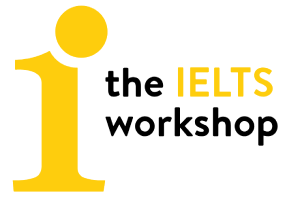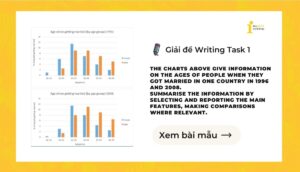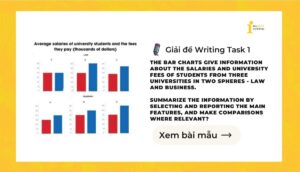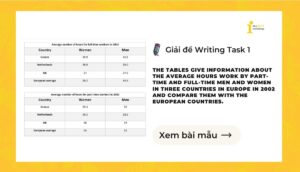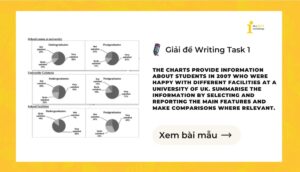Dưới đây là bài giải đề IELTS Writing Task 2 trong Test 4, Cambridge 19 với chủ đề Buy food produced all over the world do cô Đinh Thảo Chi tại The IELTS Workshop gợi ý. Cùng tham khảo cách phân tích, làm bài và ghi lại một số từ vựng hay ở cuối bài nhé.
1. Phân tích đề bài Buy food produced all over the world
1.1. Đề bài Buy food produced all over the world | IELTS Writing Task 2
In many countries nowadays, consumers can go to a supermarket and buy food produced all over the world. Do you think this is a positive or negative development?
(Ở nhiều quốc gia hiện nay, người tiêu dùng có thể đến siêu thị và mua thực phẩm được sản xuất từ khắp nơi trên thế giới. Bạn có nghĩ rằng đây là một sự phát triển tích cực hay tiêu cực?)
1.2. Phân tích đề bài
Dạng đề: Opinion Essay
Từ khóa chính:
- many countries nowadays: nhiều quốc gia hiện nay
- consumers: người tiêu dùng
- supermarket: siêu thị
- buy food produced all over the world: mua thực phẩm từ khắp nơi trên thế giới
- positive or negative development: sự phát triển tích cực hay tiêu cực
Xem thêm: Cách làm dạng Opinion essay IELTS Writing task 2
1.3. Dàn bài chi tiết
Introduction
- Paraphrase đề: Các siêu thị hiện đại thường bày bán nhiều loại thực phẩm nhập khẩu từ các quốc gia khác nhau, cho phép người tiêu dùng tiếp cận sản phẩm từ khắp nơi trên thế giới.
- Nêu quan điểm: Nhìn chung, đây là một xu hướng tích cực, dù vẫn tồn tại một số hạn chế.
Body Paragraph 1: Khía cạnh tích cực
- Lợi ích kinh tế: Thương mại quốc tế hỗ trợ nông dân và nhà sản xuất trên toàn cầu, mở ra cơ hội thị trường rộng lớn.
- Đa dạng lựa chọn cho người tiêu dùng: Người dân có thể thưởng thức những loại thực phẩm vốn không có tại địa phương.
- Ví dụ: Người châu Âu có thể ăn xoài, dứa quanh năm.
- Trao đổi và tiếp nhận văn hoá: Việc trải nghiệm ẩm thực quốc tế giúp tăng sự hiểu biết và trân trọng văn hoá nước ngoài.
- Ví dụ: Thử sushi hay pasta Ý có thể khơi gợi sự quan tâm đến văn hoá Nhật hoặc Ý.
Body Paragraph 2: Khía cạnh tiêu cực
- Sự phụ thuộc vào nhập khẩu: Nếu quá dựa dẫm vào nguồn cung quốc tế, dễ xảy ra tình trạng khan hiếm hoặc tăng giá khi có khủng hoảng toàn cầu.
- Tác động môi trường: Việc vận chuyển thực phẩm đường dài làm tăng lượng khí thải carbon.
- Ví dụ: Bơ hay cherry nhập khẩu bằng đường hàng không có lượng phát thải cao hơn nhiều so với nông sản địa phương.
- Gây khó khăn cho nông dân trong nước: Thực phẩm nhập khẩu đôi khi rẻ hơn, khiến nông dân nội địa khó cạnh tranh.
Conclusion
Khẳng định lại quan điểm: Dù việc nhập khẩu thực phẩm mang lại sự đa dạng và lợi ích kinh tế, cần kết hợp với việc hỗ trợ sản xuất nội địa và giảm thiểu tác động môi trường để phát triển bền vững.
2. Bài mẫu
In today’s globalised world, supermarkets in many countries stock a wide range of foods imported from across the globe. While this trend has both positive and negative aspects, I believe the advantages generally outweigh the drawbacks.
One of the greatest benefits of this development is the increase in consumer choice. People can enjoy foods that are not grown locally or are out of season. For instance, individuals in Europe can eat tropical fruits such as mangoes, bananas, and pineapples all year round, even in winter. This variety not only improves diet and nutrition but also makes daily meals more exciting. Furthermore, access to foreign foods promotes cultural exchange. Trying dishes such as Japanese sushi or Italian pasta can inspire people to learn more about the traditions, history, and lifestyles of those countries, fostering appreciation for their culture. Additionally, the global food trade supports economies in developing nations by creating opportunities for farmers and food producers to sell their products internationally.
However, importing food from around the world can also have downsides. The most serious issue is the environmental cost, as transporting goods long distances by air, sea, or road contributes to greenhouse gas emissions. For example, air-freighted cherries or avocados often have a significantly higher carbon footprint than locally grown produce. Moreover, the dominance of cheaper imported goods can threaten the livelihoods of local farmers, making it difficult for them to compete. There is also a risk of over-reliance on foreign food supplies, which can lead to shortages and price increases if global trade is disrupted, as seen during the COVID-19 pandemic.
In conclusion, the ability to buy food from all over the world offers undeniable benefits, including greater variety and cultural enrichment. Nevertheless, it is crucial to balance this with environmental considerations and support for local agriculture to ensure sustainable and resilient food systems.
Sample by Dinh Thao Chi – IELTS Teacher at The IELTS Workshop
3. Từ vựng
- globalised world: thế giới toàn cầu hóa
- consumer choice: sự lựa chọn của người tiêu dùng
- out of season: trái mùa
- cultural exchange: sự giao lưu văn hóa
- foster appreciation: thúc đẩy sự trân trọng
- global food trade: thương mại thực phẩm toàn cầu
- carbon footprint: lượng khí thải carbon
- greenhouse gas emissions: khí thải nhà kính
- livelihoods: sinh kế
- over-reliance: sự phụ thuộc quá mức
- resilient food systems: hệ thống thực phẩm bền vững
Xem thêm: Cách học từ vựng IELTS hiệu quả từ thầy Đặng Trần Tùng 9.0
Tạm kết
Mong rằng bài viết mẫu với chủ đề Buy food produced all over the world từ cô Đinh Thảo Chi đã giúp bạn hình dung rõ cách triển khai dạng Opinion trong IELTS Writing Task 2.
Tham khảo ngay chuyên mục [Cập nhật liên tục] Tổng hợp đề thi IELTS Writing 2025 kèm bài mẫu và Bài mẫu Writing Task 2 trên website. Đây là kho tài liệu phong phú giúp bạn củng cố kiến thức và nâng cao kỹ năng xử lý mọi dạng bài.
Đừng quên tham gia khóa HỌC IELTS MIỄN PHÍ ngay trên website – nơi bạn được đồng hành cùng đội ngũ giáo viên nhiều kinh nghiệm và nhận chỉ dẫn cụ thể cho từng dạng bài thi. Hãy đăng ký ngay hôm nay để nắm bắt cơ hội này !

